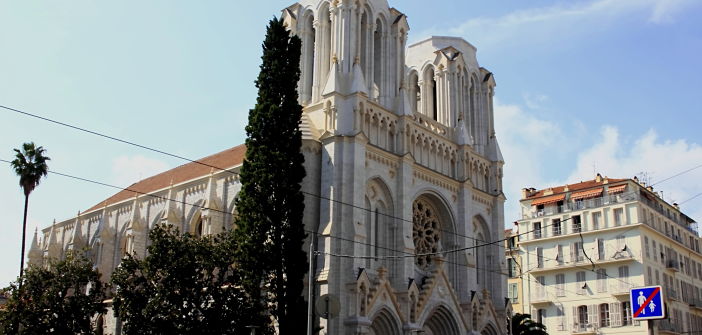Notre Dame is the largest church in Nice. While its facade evokes Notre Dame de Paris, its interior is inspired by the Saint Maurice Cathedral in Angers. Over its history, this building has had several names: Notre Dame de Longchamp, Notre Dame des Champs, names related to the neighborhood, then Notre Dame des Malades before becoming Notre Dame de l’Assomption.
By imposing the train route to the north and not the south of the city, Mayor Malausséna favored the development of this district. The Avenue du Prince Impérial led to the new railway station as early as 1864. It was in the same year, on March 12, that the foundation stone of this church was laid.
The building was made available for worship on May 4, 1868, but unfinished; it took ten more years for its final completion. Notre Dame was realized thanks to the determination of two men: Bishop Sola, a proponent of the attachment to France, and Father Lavigne.
The architect Charles Lenormand took inspiration from the 13th-century Gothic style. This burgeoning district had no place of worship that met its needs. Only the modest Saint Etienne chapel, lost in the countryside, and the one of the Charité Hospice could be found.
Father Lavigne was called to God in 1874. The city of Nice, by purchasing Notre Dame’s debts, became the owner of the building. The nature of the terrain, which consisted of watercress beds, increased the cost of the work. Father Alexandre Lavigne, a Jesuit, was appointed Vicar General for Foreigners (in Nice, the foreign population originating from the Var’s right bank was considerable).
He thus became the first parish priest of Notre Dame. The church was completed in 1879, consecrated in 1925, and elevated to the rank of Minor Basilica (the majors being only in Rome) on April 16, 1978. Notre Dame has recently undergone a complete restoration, which has restored the original whiteness of its stones.
We will conclude with Father Lavigne’s goal: to establish the Jesuits in Nice. Time and circumstances (the empire collapsed in Sedan in 1870, just as the Third Republic would seventy years later) did not allow him to realize his project. The buildings intended for the Society of Jesus housed a municipal school in 1876.
Thierry Jan


